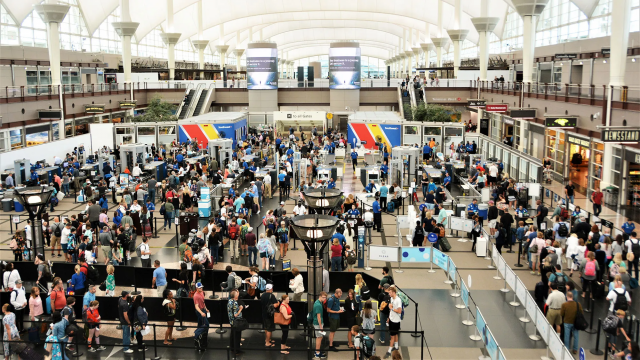Airports were crowded last year. It could be a terminal problem
2023-02-06Crowded airport gates, check-in halls and restaurants were common sights last year as Americans returned en masse to the skies and airlines suffered unusually high levels of delays and cancellations.
But a long-term dynamic poses the risk that uncomfortable levels of crowding could become the norm at many hub airports unless mitigation efforts keep pace.
The challenge: Aircraft used by large U.S. airlines are quickly getting bigger. As plane sizes increase, so do the surges of people during peak flying hours who pass through TSA security, wait at gates, use bathrooms and queue up for Starbucks.
According to travel industry consultancy Hospitio’s analysis of data from Milanamos, United was offering an average of 22% more seats per domestic flight last month than it did in January 2019, a metric known in the industry as gauge. At Delta, domestic gauge was up 13% compared with January 2019, while American’s increased 12%.
The upsizing is unfolding as airlines work to improve flight economics by reducing average operating costs per seat. They’re doing that by replacing smaller Boeing 737 and Airbus A320-series narrowbodies with stretched versions and by replacing 50-seat regional jets with regional aircraft in the 70- to 76-seat range. Delta and JetBlue are also bringing on Airbus A220 aircraft with well over 100 seats to replace regional planes.
But while upgauging has long been baked into airline business models, carriers have expedited the process over the past couple of years due to an ongoing pilot shortage that has constrained their ability to operate as many flights as they’d like.
U.S. hub airports are under pressure
To date, the Big Three U.S. carriers are still operating fewer flights than prepandemic, but total seat counts are on the brink of reaching the 2019 level. Meanwhile, at some hubs, such as American at Washington Reagan, Delta in Boston and Seattle and United in Denver and Newark, they’re already 10% above the 2019 level or more.
More problematic, said Hospitio executives Brad Beakley and John Wickson, are surges during the hours of the day when airlines operate their most flights and facilitate their largest numbers of flight connections. For example, American’s domestic departing seat count at Dallas-Fort Worth, its largest hub, was up 2% compared with 2019 in January, but during the 5 p.m. hour on average, its total number of arriving and departing seats was up 52%.
“There’s only so much room to put another line or additional screening in place,” Beakley said.
Airlines, airports and the TSA all say they’ve thought long-term about the challenges posed by increasing gauge and continue to address it.
“That’s why we have done these generational builds across our network; we knew bigger gauge was coming, and we needed to accommodate it,” Delta president Glen Hauenstein said last month in reference to ongoing or recent airport build-outs of terminals it uses in Atlanta, Salt Lake City, New York LaGuardia and LAX. “For example, here in Atlanta, we worked closely with the city to reconfigure the D Concourse to be wider than any other concourse.”
Similar steps were undertaken recently by DFW in conjunction with hub tenant American. During the pandemic, the airport opened four new Terminal D international gates and reconstructed five Terminal C gates, all designed with larger gate hold spaces than previous DFW iterations, airport CEO Sean Donohue said.
Terminal B, historically American’s regional terminal at DFW, is one area where Donohue said the airport is seeing pressure. In response, his team is working with American to convert pairs of regional jet gates into individual mainline, domestic gates.
A challenge for airport security
Upgauging, and the larger peak-hour surges that accompany it, also raises the specter of longer security lines. At DFW, Donohue said, flexibility will help with management of that issue. The airport has at least three security checkpoints in each terminal, meaning that it can readily disperse crowds among them.
Still, TSA administrator David Pekoske concedes that checkpoint capacity will be a challenge across the U.S. airport system due to upgauging, especially as airlines continue their post-pandemic recoveries. Some of the biggest challenges, he said, will be in Sun Belt airports, such as Austin, Texas, that have seen significant increases in total passenger volume. Large airports, including Newark, Denver and LaGuardia, are also front of mind.
“Many airports have completely redone their operation or have built new facilities. We know which airports will be the busiest, and we’re doing work to expand infrastructure together with the airports,” Pekoske said.
Ongoing TSA screening technology upgrades will also expand checkpoint throughput, he said.
Arrivals also present a problem.
In fact, that’s where the problems are most noticeable for airports at present, said Regine Weston, lead airport planner in the Americas for the Toronto-based design and planning firm Arup. Baggage claim systems, for example, sometimes don’t have enough capacity to handle larger planes, which is why airlines have to move bags off the belt. Problems also extend outside, to the ramp.
At Houston Bush Intercontinental and Newark, Weston is working with airport authorities and United to make changes that will accommodate the larger domestic aircraft the airline has on order.
According to Beakley, due to United’s especially aggressive upgauging, some of the biggest challenges will be at airports in which United is the hub carrier.
Courtesy of Travel Weekly


